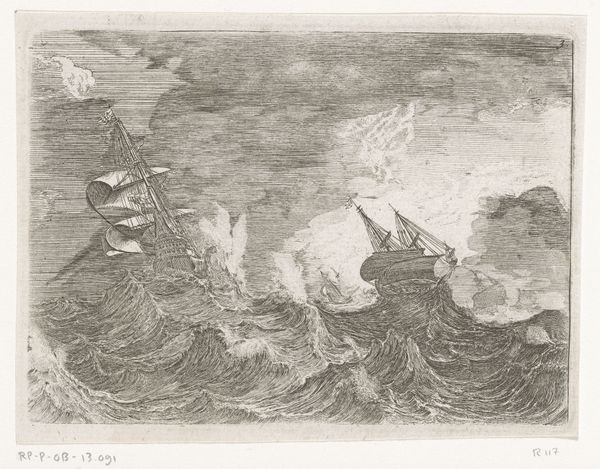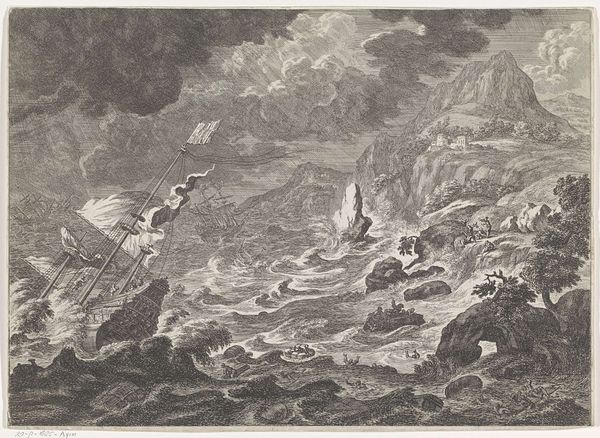
print, etching
#
narrative-art
#
baroque
# print
#
etching
#
landscape
#
cityscape
#
history-painting
Dimensions: height 316 mm, width 401 mm
Copyright: Rijks Museum: Open Domain
Curator: What an evocative scene of maritime disaster. This print, titled "Schipbreuk," meaning Shipwreck in Dutch, comes to us from Jan Lauwryn Krafft, and dates sometime between 1704 and 1765. It's an etching, a medium lending itself to such dramatic detail. Editor: Yes, a rather ominous depiction! The overwhelming waves dominate, a chaotic tangle of etched lines. The monochromatic palette really emphasizes the turbulence, creating a feeling of vulnerability. Curator: Absolutely. Shipwrecks held significant cultural weight during this era. Maritime power was so vital and to see these ships failing was a harsh commentary on the perils of Dutch expansion. It speaks to the narratives that captured the public's imagination—tales of exploration, trade, but also the ever-present threat of nature’s power. Editor: I’m struck by how the composition divides our attention. We've got a secure cliff on the left, figures clinging to safety. Then our eyes are forced rightward to a struggling boat—it's almost like an allegory, a play between safety and the perils that come with navigating dangerous waters. Curator: That's a fine reading of it. The artist perhaps is even drawing attention to the unequal access to safety in that time period. Who gets to be on the safe cliff, and who's battling for survival at sea? The narrative itself raises critical questions about societal structure, wouldn't you agree? Editor: Interesting. I see a dynamic contrast between the static mass of the cliff face and the roiling water. Those tightly controlled lines that render the fortress are just visually compelling as the loose chaotic strokes forming the storm. There’s an underlying structure at play, even amid apparent chaos. Curator: Yes, even in portraying disaster, Krafft underscores the human endeavor and ambition intertwined with the power structures and global ambitions of the period. Thanks to advancements in printmaking, art like this became quite popular, influencing public perceptions and informing national identity during a time of burgeoning naval empires. Editor: The work overall feels surprisingly immediate. It is something about the tonal gradations of the stormy clouds… very dynamic. Curator: Indeed, there’s more to this artwork than just aesthetics. Editor: Absolutely, food for thought regarding power, chaos and the society of that time period.
Comments
No comments
Be the first to comment and join the conversation on the ultimate creative platform.













